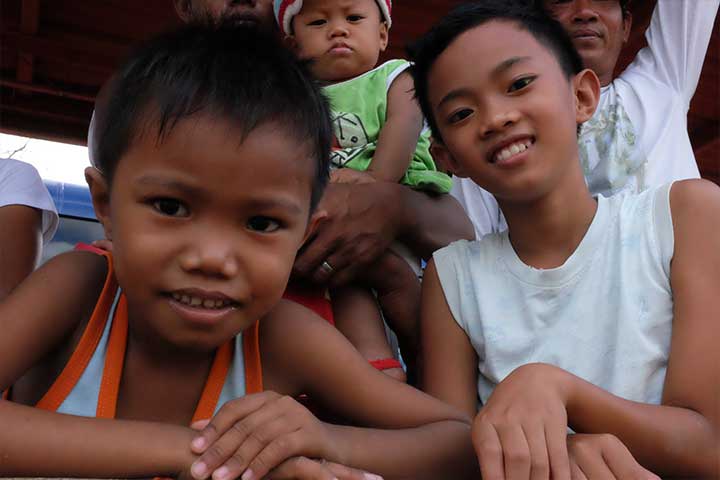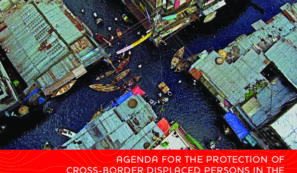
refers to situations where people flee or are displaced across borders in the context of sudden- or slow-onset disasters, or in the context of the effects of climate change.
refers to situations where people are forced to leave their homes or places of habitual residence as a result of a disaster or in order to avoid the impact of an immediate and foreseeable natural hazard. Such displacement results from the fact that affected persons are (i) exposed to (ii) a natural hazard in a situation where (iii) they are too vulnerable and lack the resilience to withstand the impacts of that hazard.
refers to a “serious disruption of the functioning of a community or a society involving widespread human, material, economic or environmental losses and impacts, which exceeds the ability of the affected community or society to cope using its own resources” (UNDRR). In the Protection Agenda, disasters refer to disruptions triggered by or linked to hydro-meteorological and climatological natural hazards, including hazards linked to anthropogenic global warming, as well as geophysical hazards. Disasters are often classified as either sudden-onset or slow-onset. Both types can lead to significant displacement, but the nature and timing of this displacement vary, with slow-onset disasters providing more time for evacuation planning, while sudden-onset disasters often requiring urgent humanitarian response.
Disaster risk is typically defined as the ‘potential loss of life, injury, or destroyed or damaged assets which could occur to a system, society or a community in a specific period of time, determined probabilistically as a function of hazard, exposure, vulnerability and capacity’ (UNDRR).
The displacement that is likely to occur in a society or a community over a specific time period, determined probabilistically as a function of hazard, exposure, vulnerability and capacity (IDMC). Efforts to manage displacement risk may include measures helping people to stay, move out of harm’s way and find solutions to their displacement.
The achievement of durable solutions for displaced populations are often a complex, long-term process that requires addressing human rights, humanitarian, development, and sometimes peace building challenges. Durable solutions are achieved when displaced people no longer require specific assistance or protection related to their displacement. This can happen when the population is reintegrated to their place of origin, locally integrated in their new community, or resettled outside of the country. (For more information, see the IASC Framework on Durable Solutions for Internally Displaced Persons).
refers to three forms of population movement: i) displacement – understood as the primarily forced movement of persons, ii) migration – primarily voluntary movement of persons, and iii) planned relocation – planned process of settling persons or groups of persons to a new location (Cancun Climate Change Adaptation Framework).
are people or groups of people who have been forced or obliged to flee or to leave their homes or places of habitual residence, in particular as a result of or in order to avoid the effects of armed conflict, situations of generalized violence, violations of human rights or natural or human-made disasters, and who have not crossed an internationally recognized State border (Guiding Principles on Internal Displacement).
Although there is no agreed definition of loss and damage, it is typically considered as the negative impacts of climate change that cannot or have not been mitigated or adapted to. Economic losses can be understood as the loss of resources, goods and services that are commonly traded in markets. Non-economic losses can be understood as the remainder of items that are not commonly traded in markets. (UNFCCC)
According to the Guidance on Planned Relocation, planned relocation is a process carried out by a governmental authority in which persons, groups, or entire communities move or are assisted in settling in a new location within the national borders and are provided with the conditions for rebuilding their lives. Relocation is typically undertaken to protect people from risks and impacts related to disasters and environmental change.
refers to any positive action, whether or not based on legal obligations, undertaken by States on behalf of disaster displaced persons or persons at risk of being displaced that aim at obtaining full respect for the rights of the individual in accordance with the letter and spirit of applicable bodies of law, namely human rights law, international humanitarian law and refugee law (Protection Agenda).
is defined as one that emerges gradually over time. Slow-onset disasters could be associated with droughts, desertification, and sea-level rise.
is triggered by a hazardous event that emerges quickly or unexpectedly. Sudden-onset disasters could be associated with earthquakes, tsunamis, and hurricanes, etc. (UNDRR)
“Climate Refugee” is often being used in the media to define a person displaced in the context of disasters like droughts, sea level rise as well as extreme weather events like hurricanes, tsunamis or earthquakes. This concept does not exist in international law and is not endorsed by the Platform on Disaster Displacement.


